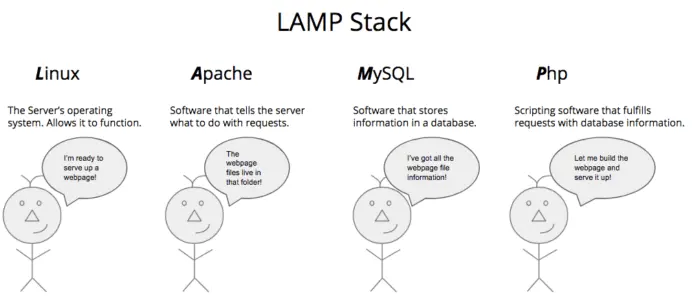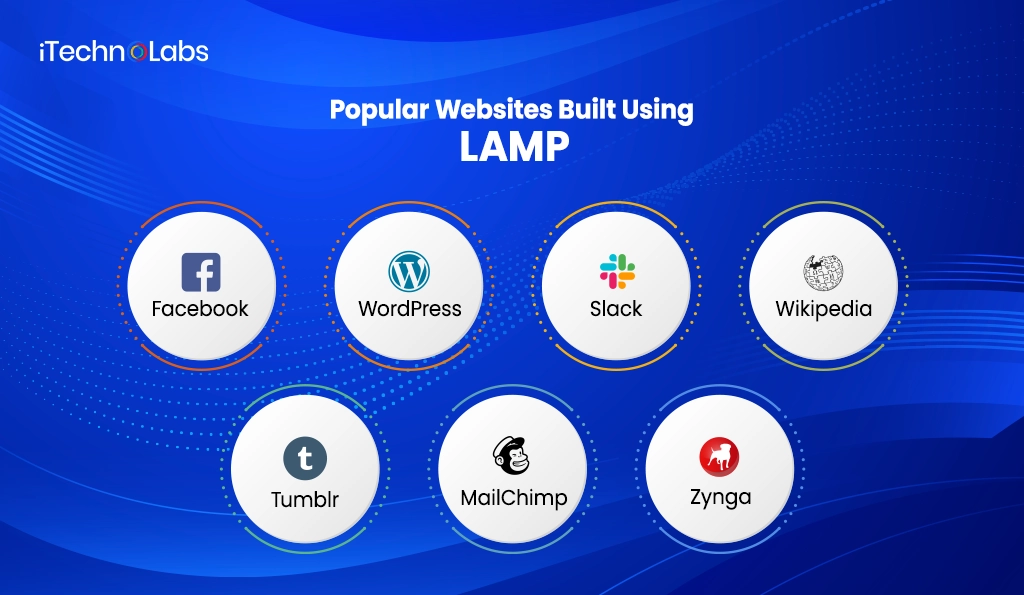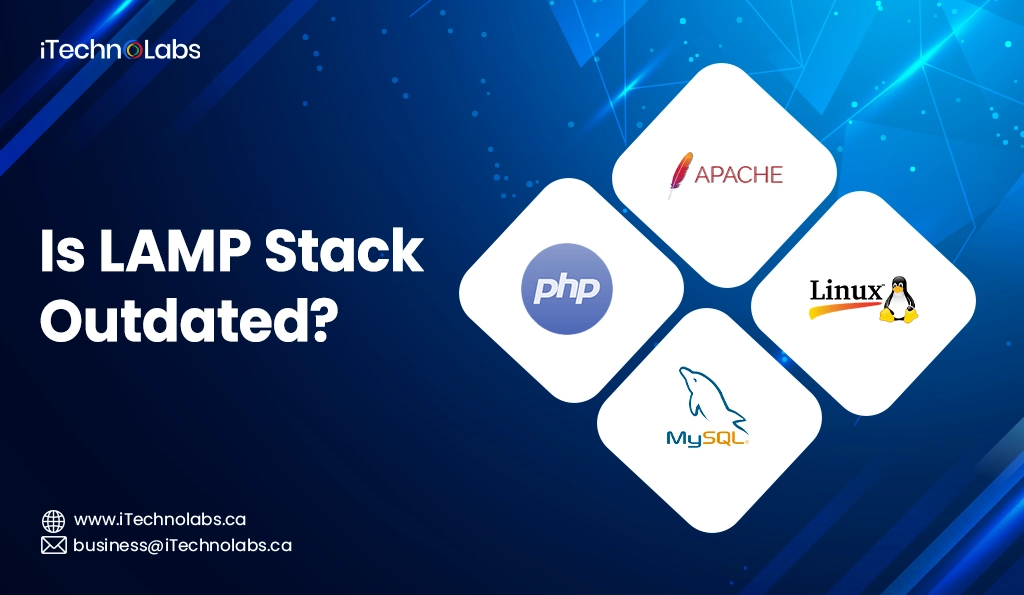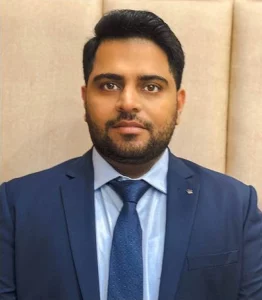LAMP — Linux, Apache, MySQL, and PHP needs no introduction! For years, it has been the foundation of web development. However, the web development sphere has evolved in recent years. This has led to the rise of a common question, “is LAMP stack outdated?”
New technologies, like RequireJS, a modern JavaScript module loader, and cloud-based solutions are emerging each day. Because of this, LAMP is now being compared to more modern options.
For over two decades, the LAMP stack has been a popular choice for web developers. The stack includes:
- a reliable operating system (Linux),
- a powerful web server (Apache),
- a flexible database management system (MySQL), and
- a scripting language (PHP).

Together, these tools help developers build dynamic websites and applications.
During the 2000s, LAMP made a big impact. It was affordable and open-source. Most developers relied on it to build websites that could manage dynamic content. The features that LAMP app stack offered made it an ideal solution for blogs, e-commerce websites, and more. Its low-cost and reliability made it the top choice for most developers.
As new technologies came along with different levels of scalability and performance, some started to ask: is LAMP stack old news? For example, modern stacks generally work to avoid issues such as circular dependencies sometimes found in old architecture.
The blog discovers the answer to this question!
History and Legacy of LAMP
LAMP was developed in the late 1990s. The acronym LAMP was given by Michael Kunze in the December 1998 issue of ‘Computertechnik’. It gained extreme popularity in the early 2000s. LAMP provided a free and open-source solution for building dynamic websites. Developers preferred LAMP because it was easy to use and set up. This raised the question even today—Is LAMP Stack Outdated or still useful for beginners and professionals alike?
LAMP transformed web development by making it accessible for a broader audience. Before LAMP, developers required costly tools and extensive programming knowledge. LAMP’s open-source nature meant anyone could contribute and improve the software. This resulted in a vibrant community that promoted innovation and support. This has laid the foundation for what we now recognize as a successful strategy for software development. Yet as new technologies emerge, many wonder: Is LAMP Stack Outdated in the age of cloud-native and containerized applications?

Many well-known websites and platforms have relied on LAMP at some point. For example, Facebook started on LAMP before scaling to more complex architectures. Other popular platforms, like WordPress, which runs over 40% of the websites on the internet, also use the LAMP stack. Despite modern alternatives, the debate—Is LAMP Stack Outdated—continues among developers choosing the right stack for their projects.
Undoubtedly, LAMP had a significant impact on the web, allowing countless developers to create and maintain websites effectively.
Check out this video to explore Is LAMP Stack Outdated in today’s tech landscape. We’ll discuss its advantages, limitations, and modern alternatives to help you decide if it’s the right choice for your projects.
LAMP Stack in 2025
Several new technology stacks have emerged in recent years, competing with LAMP.
These tools are known to be more advanced and help developers build modern, scalable web apps.
Below are the five tools that developers these days prefer over LAMP stack:
MEAN Stack (MongoDB, Express.js, AngularJS and Node.js)
MEAN uses JavaScript to build the front-end and backend of any application. It simplifies the development process by combining the codebase. MongoDB is a NoSQL database. It offers more flexibility as compared to MySQL.
This stack is best for developing dynamic single-page applications (SPAs) and real-time apps. This is because of the Node.js ability to manage multiple requests efficiently. MEAN is also scalable. That is why it is a top choice for larger, growing applications.
MERN Stack (MongoDB, Express.js, React, and Node.js)
MERN is like MEAN. However, it uses React instead of Angular to develop the front-end. React lets developers build dynamic, interactive web pages easily. The MERN stack is good for applications that need a fast and smooth user experience. If you are building a social media website or an online store, MERN is a great choice.
Further, Node.js and MongoDB help keep the app running well at the back end. These help scale the application as the traffic grows.
JAMStack (JavaScript, API, and Markup)
This stack does not create pages on servers. Instead, it delivers pre-built files from a Content Delivery Network (CDN) in real-time. This makes websites load faster, improves security, and scales better.
The JAMstack uses APIs for any additional server tasks to keep things lightweight. This stack works best for static websites, e-commerce, or any site that needs to be fast and secure.
Docker and Kubernetes
Docker enables developers to create and package applications with Docker containers that will run consistently on different environments; Kubernetes automated management, helps run these containers and their apps with the ability to scale on demand, with diminishing complexity. Together, they reduce discrepancies, on-boarding and speed to scale and deploy when using these tools which is why enterprises with complex infrastructure requirements, rely on this stack.
Serverless Architecture
This allows developers to develop applications without creating the server. The cloud supplier, such as AWS Lambda, will run the code only when needed, which helps to reduce some costs and overhead. This is perfect for an app with uncertain traffic, as it automatically scales up and down.
Serverless is the best for even-driven applications, where the server is active only during specific functions, improving both efficiency and cost-effectiveness.
Now, let’s have a head-to-head comparison of LAMP and its modern-day competitors.
| Feature | LAMP | MEAN | MERN | Serverless | Docker Kubernetes |
| Stack Components | Linux, Apache, MySQL, PHP | MongoDB, Express.js, Angular, Node.js | MongoDB, Express.js, React, Node.js | Various (e.g., AWS Lambda) | Docker, Kubernetes |
| Language | PHP | JavaScript | JavaScript | Varies (Node.js, Python, etc.) | Varies (Dockerfiles) |
| Database | MySQL | MongoDB | MongoDB | NoSQL or SQL (e.g., DynamoDB) | Any SQL/NoSQL |
| Use Case | Traditional web apps | Single-page applications | Single-page applications | Microservices, APIs | Container Orchestration |
| Scalability | Moderate | High | High | Very High | Very High |
| Performance | Good | Excellent | Excellent | Excellent | High |
| Learning Curve | Moderate | Moderate | Moderate | Low | Moderate to High |
| Deployment | Server-based | Cloud or server-based | Cloud or server-based | Cloud-based | Cloud or on-premises |
No doubt, the above alternatives provide modern solutions. However, LAMP still remains reliable for most developers and their projects. Why?
Let us explore the answer in the next section.
Suggested Article: Artificial General Intelligence (AGI): Future of AI in 2025
Strengths of LAMP Stack in 2025
LAMP continues to evolve to offer a range of benefits to developers. Here’s why it is still a strong option today:
Simplicity and Easy to Use
One of the greatest benefits of the LAMP stack is its simplicity. LAMP is easy to install and configure. Hence, even beginners can work with it. Further, each component of the stack, i.e., Linux, Apache, MySQL, and PHP, has been used for years. So, developers can easily find online resources and tutorials and learn them.
LAMP requires less customization and setup compared to modern alternatives. For projects that do not require complex architecture, like Microservices, LAMP provides a clear, and effective solution. Its ease of use makes it a great option for developers without having to face unnecessary complexity.
Reliable For Small & Medium-Sized Projects
The LAMP is still a reliable alternative for small and medium-sized projects. It has been tested and reliable for decades, making it stable and safe for many web applications. Many projects, especially with simple websites or apps such as blogs and individual websites, do not require complex stacks such as MERN or MEAN. LAMP proves to be a skilled solution. It provides stable uptime, safety and easy control.
The stack is also compatible with many hosting services, which allows developers to easily deploy and manage their sites. In short, LAMP provides all the essentials for small and mid-scale projects, without over complicating things.
Large Community Support & Services
The LAMP stack has a large community, meaning a developer could always find answers to problems easily, whether that’s guides, tutorials, or forums to investigate issues, or skills to learn. This collection of knowledge allows developers to continue to keep projects working, even if they did not receive formal training.
Furthermore, many web hosting companies also provide built-in LAMP environments, which helps convenience for users. This community support for LAMP makes it feel as obsolete as some may perceive it to be since developers will always have access to current support when using it for their needs even as new technologies appear.
Low-Cost and Open Source
So, is the LAMP stack outdated? No, and here’s another strong reason for this!
LAMP has a low-cost and open-source nature. It allows developers to use its components for free. This helps them reduce expenses for startups and small businesses. Moreover, LAMP allows developers to modify the code as per their needs without worrying about expenses like the licensing fees.
In addition, developers can find hosting solutions easily as LAMP is highly supported by web hosts. For projects on a limited budget, or those looking for maximum flexibility, LAMP’s cost advantage makes it an attractive option. This keeps it from becoming outdated.
Use Cases Where LAMP is Still Relevant

Popular Websites Built Using LAMP
- WordPress
- Slack
- Wikipedia
- Tumblr
- MailChimp
- Zynga
Here are the scenarios where LAMP still shines:
Legacy Systems
There are many older websites and apps that utilize the LAMP stack, and some businesses will forever be locked to these legacy systems. Rewriting these systems or migrating these legacy systems to a new stack will take time and significant investment. On the other hand, if these legacy systems are working well and meet the requirements of the business, it may not make sense to convert to something new.
For businesses with legacy applications, keeping the LAMP stack can make sense, especially if they don’t need modern features or heavy traffic management.
Small Websites, Blogs, and Personal Projects
Such applications are easy to set up and maintain, even for beginners. LAMP’s basic components provide all the tools needed to host a simple website without the complexity of modern stacks. Developers don’t need advanced features or high scalability for such projects.
Moreover, LAMP’s open-source nature keeps costs low. This makes LAMP an ideal option for those who want a reliable solution without the need for more complex technologies and the hassle that comes along.
Businesses With Tight Budget or No Need For Complex Scalability
Startups and small businesses can spend limited amounts on their development projects. They look for affordable and easily manageable solutions and LAMP fits their requirements the best. It is a low cost, low maintenance stack that offers good performance. Also, since anybody can access and use it, it becomes a practical choice for small businesses and startups.
So, if you are a business that needs low costs over cutting-edge technology, LAMP is your best bet.
Also, read: CRM Software: The Ultimate Guide [2025]
The Final Words
Do you think the LAMP stack is outdated? Not really. Although LAMP is not as popular as newer stacks like MEAN or MERN, it is still a well-founded choice for certain types of projects. The LAMP stack has functioned beneficially for lots of years, especially for small and medium websites. Just like a real estate agent sells “location, location, location,” many developers utilize LAMP because it is easy, stable, and has lots of community support.
However, things are changing in web development. Newer stacks are better designed to handle more complex applications that have greater scalability. If building a real-time, high traffic app or needing cloud-native features, newer stacks may be a better candidate—making some people raise the question, “Is LAMP Stack Outdated, in today’s web development?”
With that said, LAMP still isn’t outdated. It is great for projects that require budget, speed and simplicity. If you are building a small blog, a business site, or any project that doesn’t have immense scalability issues, the LAMP stack will serve its purpose. While discussions of whether “Is LAMP Stack Outdated” come into play at times, the real question relies on YOUR use case.
At the end of the day, the question really comes down to YOUR GOALS and NEEDS. When assessing your LAMP (or newer stacks) decision, always, better first assess your needs and then, Finally assess your current resources.










